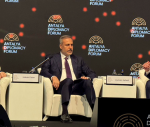You are here
CES shifts its focus to innovations changing the tech industry
By Los Angeles Times (TNS) - Jan 07,2016 - Last updated at Jan 07,2016
As CES ballooned into an overwhelming crush of products, press events and panels in recent years, longtime attendees grumbled that the consumer-electronics show was just too much stuff and not enough substance.
Bejewelled smartphone cases shared space with vibrating forks, Wi-Fi-connected washing machines were displayed alongside the latest pair of celebrity-backed headphones. The weeklong convention lacked focus, and the reasons for skipping it began to mount.
This year’s CES is slated to be the biggest ever. Despite its gargantuan footprint, show organisers say the convention will be more manageable and relevant.
There will be less emphasis on the typical CES electronics like televisions, tablets and smartphones, and more attention paid to industry-changing innovations such as connected, electric and driverless cars; the Internet of Things; drones; virtual reality and gaming; and entertainment tech. To reflect that shift, the Consumer Electronics Association, which produces CES, recently changed its name to the Consumer Technology Association — a small but symbolic move.
After several years of muted interest, that’s spurring renewed optimism about the annual trade show, held every January in Las Vegas. CES is one of the world’s biggest technology gatherings, and an estimated 150,000 to 170,000 people are expected to attend.
Don’t expect to see a groundbreaking new product category among the 3,600 exhibitors. But as fledgling tech sectors have matured, the incremental advancements should be more compelling.
Once again, automakers will command a heavy presence at CES, which in recent years has become almost as much of a car show as a consumer electronics one. Gary Shapiro, president of the Consumer Technology Association, said auto-tech companies will occupy more exhibit space than last year.
Although cars weren’t historically part of the CES lineup, the auto industry’s participation “is an absolute natural fit” as cars have become important platforms to house technology, said James Pillar, head of marketing for Bentley Motor Inc.’s Americas division.
“The car is very much a consumer product, and the level of technology in cars now is exceptional,” Pillar said. “They’re not mutually exclusive, they’re very much one and the same.”
Auto brands including BMW, Ford, Jaguar Land Rover, Mazda, Mercedes-Benz USA, Porsche and Toyota are attending. Mary Barra, chief executive of General Motors, and Herbert Diess, head of Volkswagen Passenger Cars, are giving keynote addresses.
Another big trend at CES will be the Internet of Things, as exhibitors show off a plethora of Web-connected, sensor-loaded, app-driven clothing, kitchen appliances, jewellery and thermostats. But the explosion of “smart” items has left many consumers feeling Internet of Things fatigue, so exhibitors are under pressure to prove that their gizmos are truly solving a problem and adding value.
One company hoping to tap into the wearables trend is Chronos, which makes a tiny device that transforms an ordinary wristwatch into a smartwatch that can track steps and other activity. Founder and Chief Executive Mark Nichol said the San Francisco company chose CES for the device’s public debut because “it’s where you have to be — everyone is there”.
“We think we have such a unique take on what a wearable is that we’ll really stand out,” he said. “This is the one pure wearable tech show that we’re definitely doing.”
As CES has broadened its scope, organisers have tried several strategies to manage the sprawl. Start-ups have gained greater prominence with their own dedicated exhibit area called Eureka Park that this year will be 33 per cent larger than in 2015, with 500 exhibitors and a waiting list to join.
And Shapiro said those start-ups have to offer a worthwhile, tech-driven product.
“They can’t just be a plastic case accessories company,” he said.
Of course, not everything that is heavily touted at CES goes on to become a life-changing product. Take, for instance, 3-D televisions, which were the “it” innovation of CES six years ago but quickly flamed out because of high prices, a lack of content and sceptical consumers.
Shapiro didn’t mince words when he spoke of the ultimate disappointment of 3-D TVs.
“It was overhyped and I think there were those in the industry that were delusional, frankly, and they believed their own hyperbole,” he said. “Yes, it was the talk of the show for one year because a lot of the set-makers were very excited about it, but it was definitely a mistake and it hurt industry credibility.”
Related Articles
LAS VEGAS — The battle to be at the centre of your digital life has taken on a new dimension amid a proliferation of connected devices.After
In the air, in your car, on your back — new technology at the upcoming Consumer Electronics Show (CES) is showcasing the growing number of ways to live the “connected life.”
New technology is getting more personal. So personal, it is moving to connect and analyse our movements, our health, our brains and our everyday devices.

















